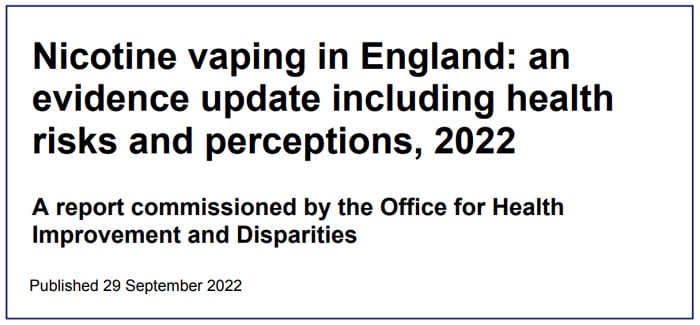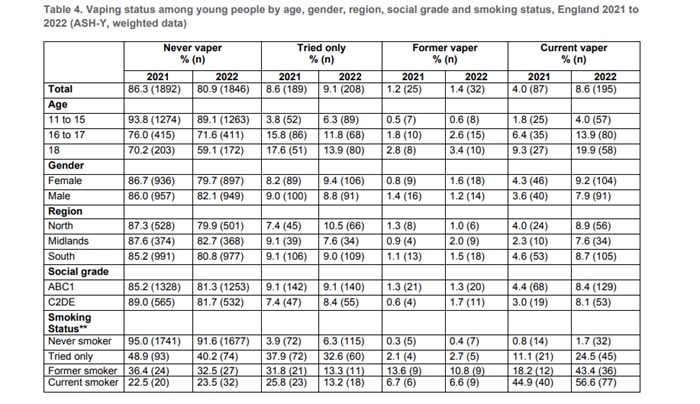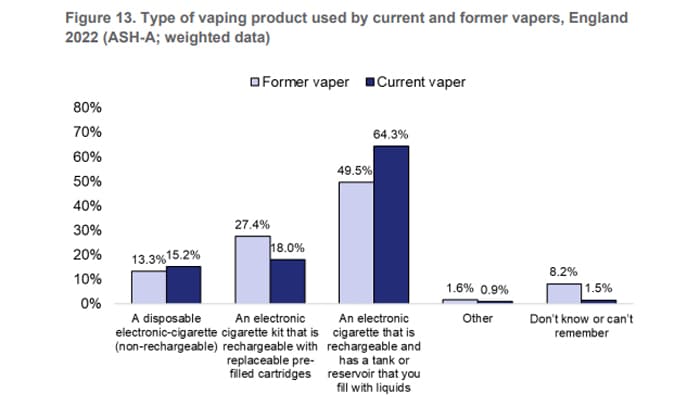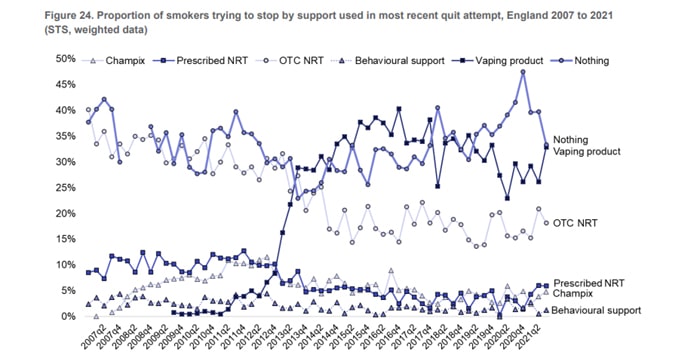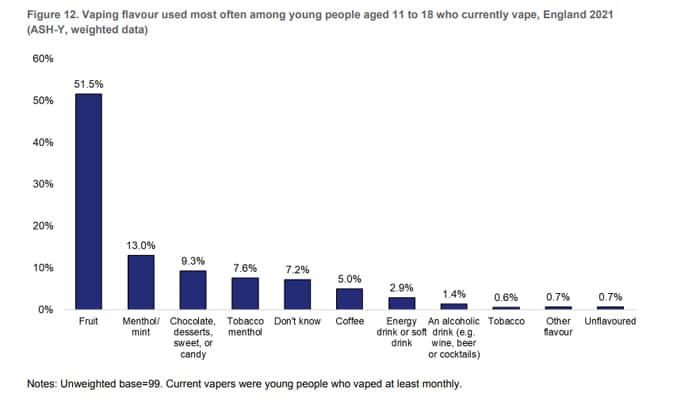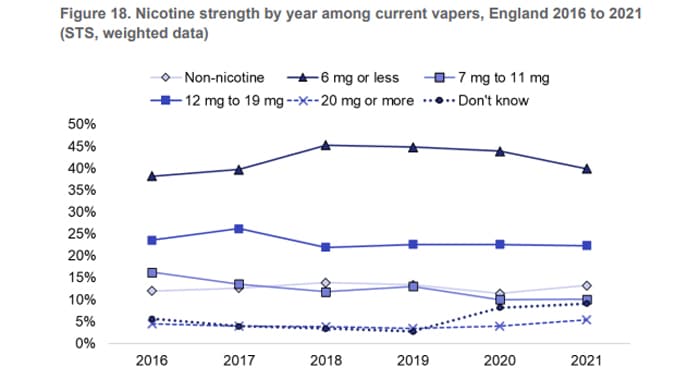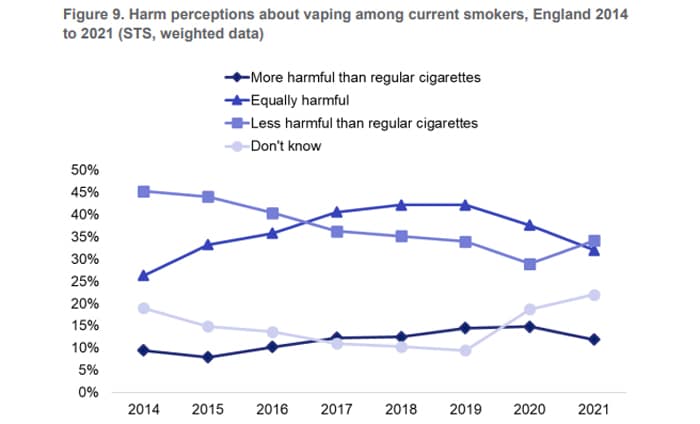King’s College London has completed an evidence based review for the UK Government Office for Health Improvement and Disparities.
The full report – available here in PDF Format – Nicotine Vaping in England – 2022 – is 1468 pages long – so I won’t go into huge depth but will instead pick out the main headlines.
In the full report it covers all areas from survey and testing methods, legislation, health, NICE guidelines, toxicity reports, policy of other countries, stop smoking services and a hell of a lot more!
Review Details
This is the 8th review in a series of independent reports commissioned originally by Public Health England to evaluate the risks of Nicotine Vaping.
It looked at the following topics…
Health Risks
A combination of human vaping exposure and that of animal and cell studies were used to compare the risks of nicotine vaping against smoking plus the absolute risks of vaping only.
The team established the following conclusions…
- in the short and medium term, vaping poses a small fraction of the risks of smoking
- vaping is not risk-free, particularly for people who have never smoked
- evidence is mostly limited to short and medium term effects and studies assessing longer term vaping (for more than 12 months) are necessary
- more standardised and consistent methodologies in future studies would improve interpretation of the evidence
- Biomarkers of potentially harmful substance levels in the body showed significantly lower biomarkers associated with cancer, respiratory and cardiovascular risk in vaping compared with smoking.
- similar or higher exposure to harmful substances from vaping compared with not using nicotine products
- no significant increase of toxicant biomarkers after short-term secondhand exposure to vaping among people who do not smoke or vape
- Although this review looked at many studies of biomarkers of potential harm, the team could draw only limited conclusions. However, better-run studies assessing short and medium term risks, found no major causes of concern associated with vaping.
Smoking and Vaping Prevalence
When it comes to young people, data from the ASH-Youth 2022 survey of 11-18 year olds showed that:
- current smoking prevalence (including occasional and regular smoking) is 6% in 2022, compared with 4.1% in 2021 and 6.7% in 2020
- current vaping prevalence (including occasional and regular vaping) is 8.6% in 2022, compared with 4% in 2021 and 4.8% in 2020
- most young people who have never smoked are also not currently vaping (98.3%)
- use of disposable vaping products has increased substantially, with 52.8% of current vapers using them in 2022, compared with 7.8% in 2021 and 5.3% in 2020
When it comes to adults, data from several national studies in England showed that:
- smoking prevalence in England in 2021 was between 12.7% and 14.9% depending on the survey, which equates to between 5.6 and 6.6 million adults who smoke
- vaping prevalence in England in 2021 was between 6.9% and 7.1%, depending on the survey, which equates to between 3.1 and 3.2 million adults who vape
- vaping prevalence among adults who have never smoked remained very low, at between 0.6% and 0.7% in 2021
- the popularity of disposable vaping products has increased among adults who vape, with 15.2% using them in 2022 compared with 2.2% in 2021
- tank type products remained the most popular vaping devices (used by 64.3% of adult vapers in 2022)
- vaping products remain the most common aid used by people to help them stop smoking
- in stop smoking services in 2020 to 2021, quit attempts involving a vaping product were associated with the highest success rates (64.9% compared with 58.6% for attempts not involving a vaping product)
- the stop smoking service data are consistent with the latest evidence from the Cochrane living systematic review on electronic cigarettes for smoking cessation which also shows vaping is effective for stopping smoking.
Flavours
Fruit flavours were the most popular – followed by Mint/Menthol.
The report states that:
Overall, there is a lack of evidence on whether flavourings affect health risks. Vaping products that contain the flavouring chemical cinnamaldehyde are a cause of concern, and regulatory bodies should review its use in e-liquids.
There is limited evidence that some flavourings in vaping products have the potential to alter cellular responses (from animal and cell studies), but less than exposure to tobacco smoke.
Nicotine
According to the report Nicotine levels are generally lower in vaping than smoking, however more experienced vapers can achieve similar levels to smoking.
Existing evidence shows that risk and dependency on nicotine is lower for vaping than smoking but can vary between products.
Harm Perceptions
In 2021 only 34% of adult smokers accurately believed that vaping was less harmful than smoking. Only 11% of smokers knew that hardly any of the risk of smoking was from nicotine.
The report says that inaccurate perceptions need to be addressed!! Woohoo!
Other conclusions…
- people’s perceptions about vaping harms can influence their subsequent vaping and smoking behaviour
- communicating accurate information about the relative harms of vaping can help to correct misperceptions of vaping, particularly among adults
- Interventions on absolute harms of vaping that aim to deter young people need to be carefully designed so they do not misinform people (particularly smokers) about the relative harms of smoking and vaping.
Further Research Recommendations
The report states that there are areas where further research is recommended…
- involving people who currently smoke or vape to help shape and design research to ensure research questions are relevant, interpret the evidence and support dissemination
- agreeing a common set of biomarkers of exposure and potential harm to be used
- standardising the definitions of who is involved in the research, their exposure to vaping and smoking, and how studies report details of the devices involved
- agreeing protocols for the different designs of studies used
- greater transparency to reduce bias in research, for example pre-registration of study protocols and analytical plans
My Conclusion
I have to say from what I have read this is hugely encouraging for the UK stance on Vaping. Hopefully the enthusiasm to replace smoking with vaping will continue!
You can read more about this in the links below…
https://www.gov.uk/government/publications/nicotine-vaping-in-england-2022-evidence-update
Our 2022 Vaping Evidence Review is now out @OHID @SwitchFinder @KingsIoPPN
Full report here 👉 https://t.co/dc8UZiZAmD
Top-line findings here 👇 pic.twitter.com/eDwDqiZ2OZ
— KCL Nicotine Research Group (@KingsNRG) September 29, 2022
Responses
The fact that well-known Anti-Vape organisation Bloomberg is actually reporting accurately on this is pretty shocking! Sadly the article in question is pay-walled but it is great to see some positive vaping news from them!
Vaping is far less risky than smoking and has a slightly better success rate than other methods of quitting cigarettes, according to a new study https://t.co/6d3AaM61lv
— Bloomberg (@business) September 29, 2022
Considering Mike Bloomberg has been vocal about how he feels about vaping – this tweet has gone down a storm on Twitter !!
Does @MikeBloomberg also read this? He should inform the #WHO immediately.
We can help you spread scientific evidences and datas! #VapingSavesLives— Panthernoster ~ every day 350 🇩🇪 die from 🚬 (@panthernoster) September 29, 2022
The irony is killing me!
🙈🙉🙊🤪🤣🤣🤣 https://t.co/YmHQ2O7yP6— Michael Redfearn (@RedfearnMike) September 29, 2022
The irony here is overwhelming: Bloomberg News is reporting accurate information…
…while @MikeBloomberg‘s @BloombergDotOrg invests $152 million per year to promote health misinformation in the tobacco control field, based on his own personal #HarmReduction denialist views. https://t.co/7CTFgqUG3b
— Charles A. Gardner, PhD (@ChaunceyGardner) September 29, 2022
Well, well, well … https://t.co/NxwUpJ0kMZ pic.twitter.com/P6H3u8Cahh
— Martin C (@NannyFreeState) September 29, 2022
As Alanis Morissette would say – “Isn’t it ironic”…
Let me know your conclusions in the comments below!
